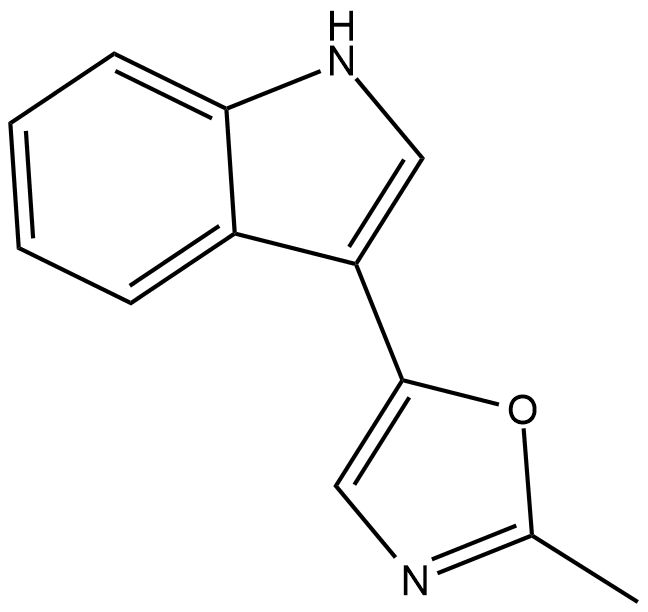Pimprinine (Synonyms: NSC 80793) |
| Catalog No.GC18707 |
Pimprinine is an alkaloid originally isolated from Streptomyces that has diverse biological activities, including anticonvulsant, antiplatelet, and antimicrobial properties.
Products are for research use only. Not for human use. We do not sell to patients.

Cas No.: 13640-26-1
Sample solution is provided at 25 µL, 10mM.
Pimprinine is an alkaloid originally isolated from Streptomyces that has diverse biological activities, including anticonvulsant, antiplatelet, and antimicrobial properties. It inhibits deamination of serotonin by monoamine oxidase (MAO; IC50 = 48 μM). Pimprinine (80 mg/kg) increases the minimum and maximum electroshock seizure thresholds in mice. In a mouse model of tremorine-induced tremors, it increases the latency to tremor onset, as well as reduces the intensity and duration of tremors and the analgesic activity of tremorine when administered at a dose of 80 mg/kg. Pimprinine inhibits aggregation of rabbit platelets induced by arachidonic acid or collagen (IC50s = 3 and 25 μg/ml, respectively) and arachidonic acid-induced thromboxane A2 (TXA2) synthesis in rabbit platelets in vitro (IC50 = 6 μg/ml). It also inhibits the growth of M. tuberculosis, P. varioti, C. albicans, and S. lutea in vitro (MICs = 25, 1, 1.5, and 2.5 μg/ml, respectively).
References:
[1].Takeuchi, T., Ogawa, K., Iinuma, H., et al. Monoamine oxidase inhibitors isolated from fermented broths J. Antibiot. (Tokyo) 26(3), 162-167 (1973).
[2].Naik, S.R., Harindran, J., and Varde, A.B. Pimprinine, an extracellular alkaloid produced by Streptomyces CDRIL-312: Fermentation, isolation and pharmacological activity J. Biotechnol. 88(1), 1-10 (2001).
[3].Umehara, K., Yoshida, K., Okamoto, M., et al. Studies on new antiplatelet agents, WS-30581 A and B J. Antibiot. (Tokyo) 37(10), 1153-1160 (1984).
[4].Intaraudom, C., Rachtawee, P., Suvannakad, R., et al. Antimalarial and antituberculosis substances from Streptomyces sp. BCC26924 Tetrahedron 67(39), 7593-7597 (2011).
| Cas No. | 13640-26-1 | SDF | |
| Synonyms | NSC 80793 | ||
| Chemical Name | 3-(2-methyl-5-oxazolyl)-1H-indole | ||
| Canonical SMILES | CC(O1)=NC=C1C2=CNC3=CC=CC=C32 | ||
| Formula | C12H10N2O | M.Wt | 198.2 |
| Solubility | DMF: soluble,DMSO: soluble,Ethanol: soluble,Methanol: soluble | Storage | Store at -20°C |
| General tips | Please select the appropriate solvent to prepare the stock solution according to the
solubility of the product in different solvents; once the solution is prepared, please store it in
separate packages to avoid product failure caused by repeated freezing and thawing.Storage method
and period of the stock solution: When stored at -80°C, please use it within 6 months; when stored
at -20°C, please use it within 1 month. To increase solubility, heat the tube to 37°C and then oscillate in an ultrasonic bath for some time. |
||
| Shipping Condition | Evaluation sample solution: shipped with blue ice. All other sizes available: with RT, or with Blue Ice upon request. | ||
| Prepare stock solution | |||

|
1 mg | 5 mg | 10 mg |
| 1 mM | 5.0454 mL | 25.227 mL | 50.4541 mL |
| 5 mM | 1.0091 mL | 5.0454 mL | 10.0908 mL |
| 10 mM | 0.5045 mL | 2.5227 mL | 5.0454 mL |
Step 1: Enter information below (Recommended: An additional animal making an allowance for loss during the experiment)
 g
g
 μL
μL

Step 2: Enter the in vivo formulation (This is only the calculator, not formulation. Please contact us first if there is no in vivo formulation at the solubility Section.)
Calculation results:
Working concentration: mg/ml;
Method for preparing DMSO master liquid: mg drug pre-dissolved in μL DMSO ( Master liquid concentration mg/mL, Please contact us first if the concentration exceeds the DMSO solubility of the batch of drug. )
Method for preparing in vivo formulation: Take μL DMSO master liquid, next addμL PEG300, mix and clarify, next addμL Tween 80, mix and clarify, next add μL ddH2O, mix and clarify.
Method for preparing in vivo formulation: Take μL DMSO master liquid, next add μL Corn oil, mix and clarify.
Note: 1. Please make sure the liquid is clear before adding the next solvent.
2. Be sure to add the solvent(s) in order. You must ensure that the solution obtained, in the previous addition, is a clear solution before proceeding to add the next solvent. Physical methods such as vortex, ultrasound or hot water bath can be used to aid dissolving.
3. All of the above co-solvents are available for purchase on the GlpBio website.
Quality Control & SDS
- View current batch:
- Purity: >98.00%
- COA (Certificate Of Analysis)
- SDS (Safety Data Sheet)
- Datasheet
Average Rating: 5 (Based on Reviews and 22 reference(s) in Google Scholar.)
GLPBIO products are for RESEARCH USE ONLY. Please make sure your review or question is research based.
Required fields are marked with *



















